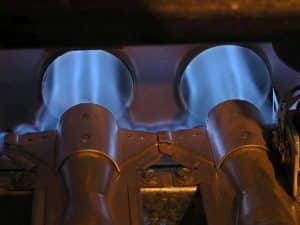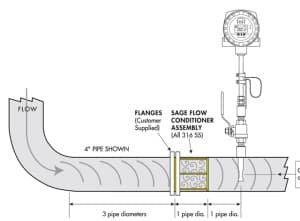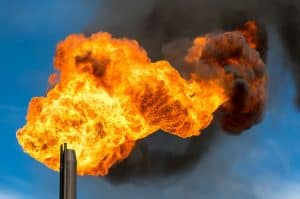The following is a Q&A on frequently asked questions regarding thermal mass flow meters. Here, we address questions on the advantages and disadvantages of thermal mass flow technology, typical end-user pitfalls, application suitability, and installation best practices below.
What are the primary limitations of thermal mass flow meters?
The end-user must utilize the thermal mass flow meter on the gas the meter is calibrated for, as changing the gas composition will degrade the accuracy. The flow meter should not measure wet gas, as condensed drops of liquid contacting the sensor may cause spiking and reduce the accuracy. Also, rapid changes in gas temperature may result in some instability during these transitional periods, as the gas flow measurement with thermal mass flow meters is based on the temperature difference between the sensors.
Read more to learn how to overcome nine thermal mass flow meter limitations.

What gas flow applications best suit thermal mass flow meters, and why?
Thermal mass flowmeters are successful in numerous gas flow applications. A common use is measuring natural gas flow to combustion sources (e.g., boilers, furnaces, heaters) for energy management and environmental reporting. Also, the submetering of natural gas for cost accounting, process efficiency, and tenant billing are frequent applications. Air flow measurement for combustion air or compressed air is also widespread. The primary benefits of selecting this technology in these applications are that the meter obtains mass flow measurement, is easy to install, has excellent turndown capabilities, low-pressure drop, and has low installation cost.
Read more about the fundamentals of thermal mass flow and seven applications.
When specifying thermal mass flow technology, what key considerations must end-users consider to ensure the meter matches the application’s needs?
The end-user must have a complete understanding of the flowmeter’s use. To do so, the user should provide the flow meter manufacturer with the range of flow rates, temperature ranges, pressure, and gas composition (and gas composition changes if applicable), along with a description of the piping system, including the length of the pipe’s straight run and upstream disturbances.
Please read Bob Steinberg’s article “Specifying a thermal mass flowmeter for gases” on P.I. Process Instrumentation.

What common pitfalls do end-users encounter when specifying and using thermal mass flow meters?
Often, the end-user overlooks installation considerations, especially the length of the pipe’s straight run. The flow profile in the installation must be the same as during calibration. During calibration, the flow profile is usually fully developed, which occurs after a sufficient straight run (typically 15 pipe diameters after a single elbow and longer distances for other flow disturbances). If these distances are unavailable, then a flow conditioner is an option.
Learn more in Gary Russell’s article, “5 factors that impact thermal mass flowmeter accuracy, flow profile and conditioning,” on P.I. Process Instrumentation.
What are the key challenges of using thermal mass flow meters in flare gas measurement applications? How can these challenges be overcome?

Thermal mass flow meters are successful in flare gas applications in the gas and oil fields where the gas source is relatively consistent. Challenges in these applications include rapid changes in flow rates and carry-over of material, which can damage the sensor. Damaging the sensor can be avoided by using a heavy-duty probe and sensor.
Flare applications at an oil refinery or petrochemical plant may have varying gas compositions depending on what section of the refinery releases gas to the flare. For this reason, when an accurate gas measurement is needed, we do not recommend using thermal mass flow meters in the main flare headers. The ultrasonic gas flow meter works well in this application. While thermal mass flow meters are unsuitable for the main flare header, they work well in the branch manifolds and indicate the release source, which is helpful to operations and maintenance departments.
Read more to learn four challenges (with solutions) of flare gas metering.
This article was initially published on Flow Control Network (now P.I. Process Instrumentation). You can download the original article “All You Ever Wanted to Know about Thermal Mass Flow Meters” by Wayne Shannon.

